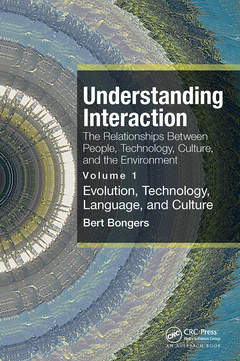Description
Understanding Interaction: The Relationships Between People, Technology, Culture, and the Environment
Volume 1: Evolution, Technology, Language and Culture
Author: Bongers Bert
Language: English
Subjects for Understanding Interaction: The Relationships Between...:
Keywords
Understanding Interaction; Xerox PARC; Wind Mills; Australian Aboriginal Culture; Musical Instrument Design; Electrical Technology; Douglas Engelbart; Electronic Musical Instruments; Kas Oosterhuis; Steven Mithen; Early Hominins; Active Mechanical Systems; Haptic Feedback; Meteorite Impact Craters; Phatic Communication; Australopithecus Afarensis; TU Delft; Interactivated Rehabilitation; Platypus; Ornithorhynchus Anatinus; Vice Versa; Firestick Farming; Homo Naledi; Easter Island; Electrical Energy
Prix indicatif 40,18 €
Disponible chez l'éditeur (délai d'approvisionnement : 14 jours).
Add to cartPublication date: 05-2022
Support: Print on demand
Prix indicatif 77,28 €
Disponible chez l'éditeur (délai d'approvisionnement : 15 jours).
Add to cartPublication date: 12-2021
· 15.6x23.4 cm · Relié
Résumé
/li>Sommaire
/li>Lectorat
/li>Biographie
/li>
Understanding Interaction explores the interaction between people and technology in the broader context of the relations between the human-made and the natural environments. It is not just about digital technologies ? our computers, smartphones, the Internet ? but all our technologies, such as mechanical, electrical, and electronic. Our ancestors started creating mechanical tools and shaping their environments millions of years ago, developing cultures and languages, which in turn influenced our evolution.
Volume 1 looks into this deep history, starting from the tool-creating period (the longest and most influential on our physical and mental capacities) to the settlement period (agriculture, domestication, villages and cities, written language), the industrial period (science, engineering, reformation, and renaissance), and finally the communication period (mass media, digital technologies, and global networks).
Volume 2 looks into humans in interaction ? our physiology, anatomy, neurology, psychology, how we experience and influence the world, and how we (think we) think. From this transdisciplinary understanding, design approaches and frameworks are presented to potentially guide future developments and innovations.
The aim of the book is to be a guide and inspiration for designers, artists, engineers, psychologists, media producers, social scientists, etc., and, as such, be useful for both novices and more experienced practitioners.
Image Credit: Still of interactive video pattern created with a range of motion sensors in the Facets kaleidoscopic algorithm (based underwater footage of seaweed movement) by the author on 4 February 2010, for a lecture at Hyperbody at the Faculty of Architecture, TU Delft, NL.
Preface. Author. 1 Interacting – Overview of design and research for interaction. 2 Evolving – Technocultural periods and technology categories. 3 Creating – Dedicated tool making and the emergence of language. 4 Settling – Agriculture, mechanical tools, and writing. 5 Industrialising – Science, enlightenment, reformation, and renaissance. 6 Communicating – Information, representation, and semiotics. Interface – Connecting volume 1 and volume 2—preliminary frameworks and directions. References. Index.
Bert Bongers is an associate professor with the Faculty of Design, Architecture, and Building at the University of Technology Sydney, Australia.

